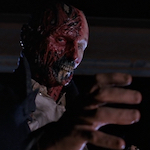 After his horror breakthrough, his failed comedy, and his knockout horror sequel, Sam Raimi finally made it to the semi-big-time. He’d really wanted to do a movie of Batman or The Shadow, but could never get the rights. Then he came up with the idea for his own dark avenger, one with the ability to change his face. His 40-page treatment The Darkman was greenlit by Universal Studios in 1987.
After his horror breakthrough, his failed comedy, and his knockout horror sequel, Sam Raimi finally made it to the semi-big-time. He’d really wanted to do a movie of Batman or The Shadow, but could never get the rights. Then he came up with the idea for his own dark avenger, one with the ability to change his face. His 40-page treatment The Darkman was greenlit by Universal Studios in 1987.
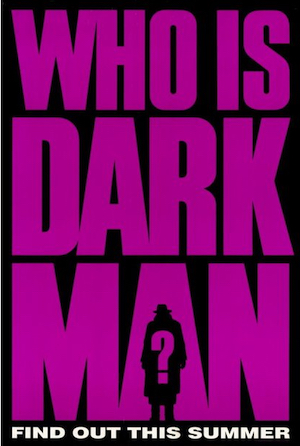 Raimi brought in NAVY SEALS writer Chuck Pfarrer to flesh out the treatment as a screenplay, which was then rewritten by Raimi and his brother Ivan (under the theory that Ivan, a doctor, could help make the medical sci-fi aspects plausible). The studio brought in the team of Daniel and Joshua Goldin (up-and-comers they also had working on PROBLEM CHILD) to bring the various drafts together before the Raimis went at it again. By the time the movie was made and released at the end of August, 1990, Tim Burton had made his BATMAN movie and all the studios were trying to mimic that success. Surely that was an influence on Raimi’s choice of composer Danny Elfman, and on the minimalist marketing campaign based around a silhouette and the question “Who is Darkman?”
Raimi brought in NAVY SEALS writer Chuck Pfarrer to flesh out the treatment as a screenplay, which was then rewritten by Raimi and his brother Ivan (under the theory that Ivan, a doctor, could help make the medical sci-fi aspects plausible). The studio brought in the team of Daniel and Joshua Goldin (up-and-comers they also had working on PROBLEM CHILD) to bring the various drafts together before the Raimis went at it again. By the time the movie was made and released at the end of August, 1990, Tim Burton had made his BATMAN movie and all the studios were trying to mimic that success. Surely that was an influence on Raimi’s choice of composer Danny Elfman, and on the minimalist marketing campaign based around a silhouette and the question “Who is Darkman?”
I’m sure at the time I would’ve been interested in this movie anyway, but I was specifically excited when I read that it was the genius behind beloved video favorite EVIL DEAD II taking his first shot at a large scale mainstream movie. Seeing the posters, reading about it in magazines, seeing it on the big screen, I accepted it as a big time summer blockbuster alongside DICK TRACY, BACK TO THE FUTURE III and DIE HARD 2. But Raimi having four times his budget on EVIL DEAD II still meant about a third or a fourth of the budgets of those films. Even Cannon’s DELTA FORCE 2, released the same day as DARKMAN, had a slightly higher budget. I think it’s a testament to Raimi’s exciting directorial style that his many green screen and miniature techniques, which have dated technically more than any of those other movies, still seemed flashy enough to stand toe-to-toe with them.
I wrote about DARKMAN in 2009, and other than an unfortunate use of the r-word (not knowing better terminology for Larry Drake’s L.A. Law character at the time) I think the review holds up as a description of what I love about the movie. So I’ll try not to overlap with that one too much.
DARKMAN is the story of Peyton Westlake (Liam Neeson following THE DEAD POOL and NEXT OF KIN), a scientist who believes he’s very close to a breakthrough on his “liquid skin” for burn victims. His real achievement seems to have been inventing 3D printing – his computers create wireframe models of facial features from photographs and then build them from tubes of his skin compound. The trouble is that the skin always turns to goo after being exposed to light for 99 minutes. (Another problem is that Westlake never seems to look at his stop watch until 98 minutes.)
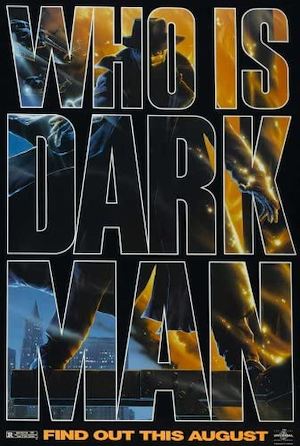 Neeson is very natural in these early scenes and helps to ground the sometimes-awkward sci-fi exposition (“Why won’t the liquid skin last?”). And I’m sure his The-Shadow-like nose didn’t hurt in auditions. At the time he was an unknown quantity, a few years later he’d rocket to acclaim and an Oscar nomination starring in SCHINDLER’S LIST. So it’s interesting to return to DARKMAN in his post-TAKEN days when we think of him as an action guy. With all that makeup and those bandages surely stuntmen do most of the darting around and jumping away from explosions, but there’s definitely a part where Neeson hangs off of a helicopter! What stands out from his other roles, both dramatic and ass-kicking, is the operatic-ness, the mega-ness, the showy theatricality that comes with a character whose face is burnt off and whose super powers include violent mood swings. But I’m getting ahead of myself.
Neeson is very natural in these early scenes and helps to ground the sometimes-awkward sci-fi exposition (“Why won’t the liquid skin last?”). And I’m sure his The-Shadow-like nose didn’t hurt in auditions. At the time he was an unknown quantity, a few years later he’d rocket to acclaim and an Oscar nomination starring in SCHINDLER’S LIST. So it’s interesting to return to DARKMAN in his post-TAKEN days when we think of him as an action guy. With all that makeup and those bandages surely stuntmen do most of the darting around and jumping away from explosions, but there’s definitely a part where Neeson hangs off of a helicopter! What stands out from his other roles, both dramatic and ass-kicking, is the operatic-ness, the mega-ness, the showy theatricality that comes with a character whose face is burnt off and whose super powers include violent mood swings. But I’m getting ahead of myself.
Westlake non-romantically proposes to his girlfriend Julie Hastings (Raimi’s Silverlake housemate Frances McDormand, who had played a nun in CRIMEWAVE), but she’s got other things on her mind. Having stumbled across “the Bellisarius Memorandum” (a great name for a band), which seems to casually discuss a real estate mogul bribing a zoning commission, she goes to confront the apparent culprit, Louis Strack Jr. (Scottish-born Australian actor Colin Friels, completely fooling me into thinking he was American). Strack tries to charm her, admits the crime but claims it’s for the greater good, and tries to get her to give him the memo. But she didn’t bring it with her. She left it at Peyton’s place.
That night a gang of thugs led by Robert G. Durant (Emmy winner for L.A. Law and future DR. GIGGLES Larry Drake) burst into the lab demanding the memo, and still blow up Westlake after they find it. In a classic Raimi move, we take on Westlake’s P.O.V. as he looks around and each of the invaders make a threatening gesture toward the camera. It playfully puts us in the middle of the action while also giving Westlake (and the audience) a moment to register the faces of each of the people he will be avenging later.
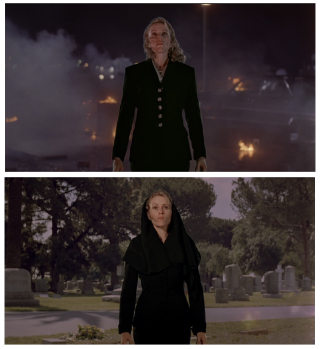 Everything about the scene is ultra-Raimi: the CRIMEWAVE-like glee of the tormenters, the grueling horror of what they put Westlake through (including his hand burning to a crisp in a stop motion shot created by KILLER KLOWNS FROM OUTER SPACE directors the Chiodo Brothers), the ironically playful tension of the explosion being triggered by a drinking bird toy, looking enormous as its beak pecks threateningly at the camera. Julie arrives just in time to witness the explosion, standing so close that it blows her hair back. The shot of her staring at the wreckage in shock dissolves to her standing in the same pose, alone at his funeral, like something out of a Hitchcock movie.
Everything about the scene is ultra-Raimi: the CRIMEWAVE-like glee of the tormenters, the grueling horror of what they put Westlake through (including his hand burning to a crisp in a stop motion shot created by KILLER KLOWNS FROM OUTER SPACE directors the Chiodo Brothers), the ironically playful tension of the explosion being triggered by a drinking bird toy, looking enormous as its beak pecks threateningly at the camera. Julie arrives just in time to witness the explosion, standing so close that it blows her hair back. The shot of her staring at the wreckage in shock dissolves to her standing in the same pose, alone at his funeral, like something out of a Hitchcock movie.
Julius Harris cameos as a gravedigger who explains he didn’t have much to bury. That’s because Westlake survived, his flaming body was launched into the river and when he floated ashore somewhere he was mistaken for a homeless John Doe. AMERICAN WEREWOLF IN LONDON’s Jenny Agutter gets the job of explaining to some visiting doctors (including John Landis and Sam Raimi) about the “radical procedure” of removing the patient’s nerve endings to save him from endless pain. Side effects include amplified emotions “giving rise to alienation and loneliness,” uncontrollable rage, and surges of strength-enhancing adrenaline. Oh well! (I like both this far-fetched origin – apparently approved by Dr. Ivan Raimi, M.D. – and the device in which it’s delivered to us.)
As I mentioned in the previous review, I think Dr. Peyton Westlake makes some very, very, very poor life choices. But I think we can attribute them to his surgery-heightened emotions. He becomes so sensitive to the idea that his burns (makeup by EVIL DEAD II’s rising special effects star Tony Gardner) make him a “freak” or a “monster” that he refuses to let Julie know about them and does not get any type of professional treatment. He’d rather slink around in his Phantom of the Opera coat, yelling at the cat in the makeshift lab he set up in an abandoned factory, or hiding inside a vent spying on Julie ballroom dancing with Stack at a work party. He’s still sensitive about it after Julie knows the truth, but by then he seems pretty cognizant of the fact that maybe having committed an elaborate series of revenge murders is more disqualifying for their relationship. In his final decision to drop Strack rather than save his life I think he’s making the choice to not be a hero or person worthy of Julie’s love. Real drama queen I am utterly alone shit there, Darkman. Get over yourself. I love you though.
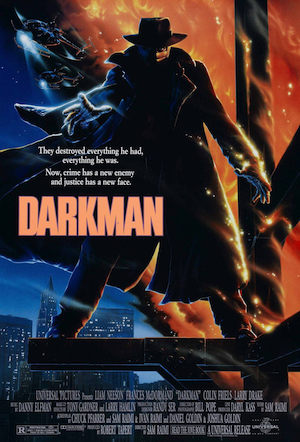
Like the same summer’s GREMLINS 2: THE NEW BATCH, this is one of the many movies where the villain is partly an overly kind caricature of a then-infamous-real-estate-creep who would fail upwards to become our nation’s most disastrous and traitorous president. Strack talks a big game about his egomaniacal skyscraper development being “acres reclaimed from decay” and providing “thousands of jobs,” and of course he’s just another famous rich guy who’s a mob affiliated crook getting his way via bribes, mob hits, and abducting women. He claims “I destroy to create something better,” referring to his stupid buildings, but he also destroyed Dr. Peyton Westlake and his medical breakthrough to create a guy who commits revenge murders with cool masks. Better for our entertainment, but not for the world, most likely.
Strack tries to sound like a man of the people when he brags about his “old man” having made him work on skyscrapers growing up (explaining why he can nimbly jump around on the metal beams while fighting Darkman). But of course none of his co-workers at that job inherited the company like he did. This guy never touched a bootstrap in his life, let alone pulled himself up by them.
The board room villain vs. the shadowy mummy man perched between gargoyles is a pretty cool clash of styles. Raimi often cites the Universal horror movies as inspirations for the character, with the FRANKENSTEIN-like mad scientist laboratory and PHANTOM OF THE OPERA isolation being obvious parallels. But I think he’s also kind of like a more action-oriented version of Vincent Price’s gimmicky murderer characters. Like Dr. Phibes, he’s a heartbroken psycho who wears a mask of his former self to hide a burnt, skull-like face, and goes after a list of people who wronged him. We marvel at the clever ways he goes after them, such as drugging Pauly (Nicholas Worth, SCREAM BLACULA SCREAM, THE GLOVE, CITY HEAT, ACTION JACKSON) and then impersonating him to do a pickup so that Durant thinks he’s running off with his money.
What makes Darkman seem sort of like a super hero is that his victims really are criminals who murdered his assistant, destroyed his life and maintain a collection of human fingers. And then he jumps from building to building with explosive shells blowing up around him and hangs onto a helicopter and gets dangled around in traffic. It’s fun to see Raimi’s energetic action expanded to this larger canvas. He pulled off so much in and around that cabin, and in CRIMEWAVE’s apartments, but now it’s across rooftops, on highways, above the city on a skyscraper under construction.
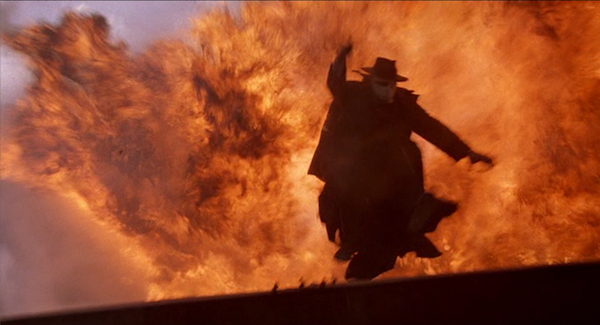
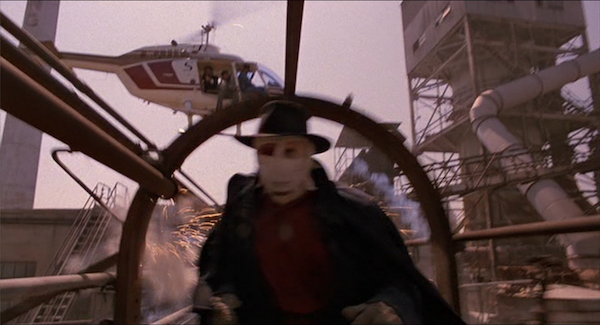
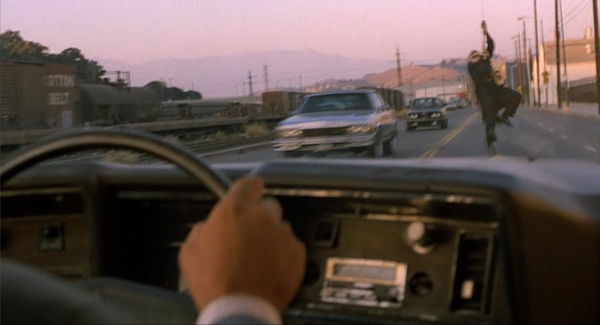
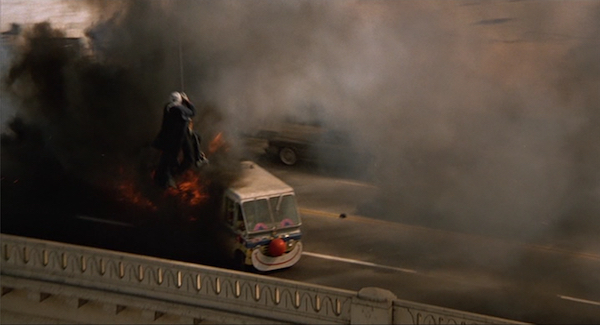
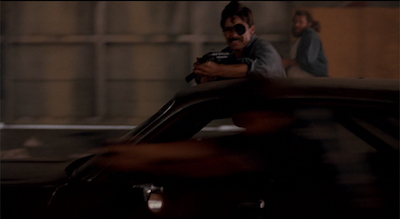 In my old review I called the opening shootout a tribute to John Woo’s HARD BOILED, a real good theory until you consider that DARKMAN came out two years before HARD BOILED. Now that I realize that Raimi and Woo separately staged these over-the-top gang battles with cars bursting out of wooden crates and guys with eyepatches firing uzis out the side it makes even more sense that Raimi would go on to shepherd Woo in his first Hollywood production HARD TARGET (also produced by Universal, written by Pfarrer and featuring Ted Raimi). In this sense Peyton Westlake and Chance Boudreaux are cousins or something.
In my old review I called the opening shootout a tribute to John Woo’s HARD BOILED, a real good theory until you consider that DARKMAN came out two years before HARD BOILED. Now that I realize that Raimi and Woo separately staged these over-the-top gang battles with cars bursting out of wooden crates and guys with eyepatches firing uzis out the side it makes even more sense that Raimi would go on to shepherd Woo in his first Hollywood production HARD TARGET (also produced by Universal, written by Pfarrer and featuring Ted Raimi). In this sense Peyton Westlake and Chance Boudreaux are cousins or something.
Since Neeson and McDormand had already appeared in a few high profile films, DARKMAN’s biggest discovery might be director of photography Bill Pope, who had shot music videos for Chris Isaak, Peter Gabriel and Metallica, plus (according to IMDb) a 1989 horror movie I can’t find anywhere called DEATH DOLL. DARKMAN is Pope’s first major feature film, and it’s clear that he was an ideal candidate to dig into Raimi’s inventive shooting style. He would reunite with the director for three more films, while also shooting CLUELESS, BOUND, SCOTT PILGRIM VS. THE WORLD, ALITA: BATTLE ANGEL and, most impressively, the original three THE MATRIX movies.
 There are plenty of cool shots in that warehouse scene (machine-gun-leg first person shooter, for example) but arguably the most exciting visuals happen when no one’s getting shot at. There’s an unmistakably Raimi science montage full of dissolves, pinwheeling cameras and floating beakers and test tubes. He goes even wilder in his expressionistic depictions of Darkman’s fits of rage, racing through firing synapses, traumatic memories and funhouse mirror delusions stretching and oozing like taffy.
There are plenty of cool shots in that warehouse scene (machine-gun-leg first person shooter, for example) but arguably the most exciting visuals happen when no one’s getting shot at. There’s an unmistakably Raimi science montage full of dissolves, pinwheeling cameras and floating beakers and test tubes. He goes even wilder in his expressionistic depictions of Darkman’s fits of rage, racing through firing synapses, traumatic memories and funhouse mirror delusions stretching and oozing like taffy.
Darkman’s most memorable freak out is when his day at the carnival with Julie devolves into breaking a carnie’s fingers just before his fake face starts bubbling in the sun and he runs away crying “Forgive me!” Not one of the more romantic endings to a date, in my opinion.
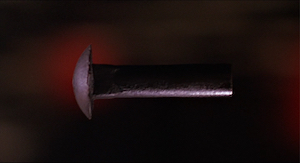 The most “oh, that’s like EVIL DEAD II” moment might be when Strack is firing bolts at Darkman and the camera follows alongside them and then switches to their POV, just like demon Henrietta’s flying eyeball. I’ve always felt that when Westlake is alone dancing around chanting “only five bucks to see the dancing freak!” it’s very reminiscent of Ash completely losing it while the furniture laughs at him. And I noticed that he yells “They took my hand!,” referring to chemical burns rather than possession. Only on this viewing did I learn that the guy with the machine gun leg at the beginning is Dan Hicks – Jake from EVIL DEAD II. Better yet, when Darkman is dangled into traffic, it’s the EVIL DEAD Oldsmobile he crashes into on the freeway. And inside it are, I have read, Raimi’s housemates/CRIMEWAVE co-writers Joel and Ethan Coen.
The most “oh, that’s like EVIL DEAD II” moment might be when Strack is firing bolts at Darkman and the camera follows alongside them and then switches to their POV, just like demon Henrietta’s flying eyeball. I’ve always felt that when Westlake is alone dancing around chanting “only five bucks to see the dancing freak!” it’s very reminiscent of Ash completely losing it while the furniture laughs at him. And I noticed that he yells “They took my hand!,” referring to chemical burns rather than possession. Only on this viewing did I learn that the guy with the machine gun leg at the beginning is Dan Hicks – Jake from EVIL DEAD II. Better yet, when Darkman is dangled into traffic, it’s the EVIL DEAD Oldsmobile he crashes into on the freeway. And inside it are, I have read, Raimi’s housemates/CRIMEWAVE co-writers Joel and Ethan Coen.

In unrelated news, MANIAC COP director William Lustig is credited as playing a dockworker, and I believe this is him in the middle here.
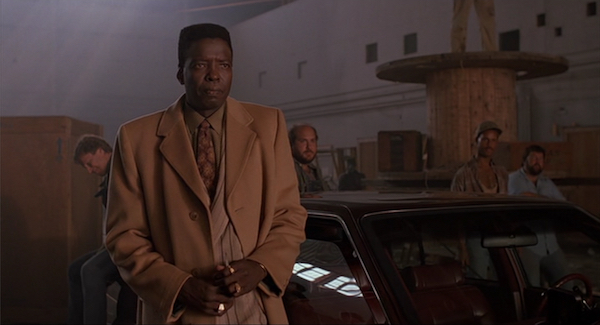
I’m not sure which dockworkers are Scott Spiegel or Neal McDonough, but they’re in there too.
more trivia: This time I noticed that the stray cat in Darkman’s lab looks like Church from PET SEMATARY, so I looked it up and learned that other people believe it “likely” is since it’s the same animal trainer.
The Shout Factory blu-ray has some good interviews with Neeson and McDormand, who are both very thoughtful in their responses and appreciative of the movie. One funny part is that McDormand says she wasn’t aware of any cult following until they asked her to do the interview, she mentioned it to the makeup artist on Olive Kittredge, and he gushed to her about his love for the movie. It’s a cute story but also evidence that nobody ever had the balls to ask her about DARKMAN before! You know somebody had to have wanted to.
McDormand praises Raimi for pushing for her over the more established actors the studio wanted, and for working with her to make the character, as she puts it, feminist. It was important to her for Julie to be an accomplished professional, though she now notes that “just because she has a job doesn’t make her not a damsel in distress.” Watching it now I find it frustrating that Julie not only doesn’t suspect her transparently douchebag boss’s involvement in the explosion the day she uncovered his crimes and discussed the location of the incriminating paperwork, but that she responds positively to his romantic gestures. Nothing against the actor, but he doesn’t have the charisma to make this catastrophic lapse in judgment understandable.
I want to note that some ethnic depictions in the movie seem… if not flat out racist, at least antiquated, particularly in the case of Asians. When the lab is attacked, Westlake’s assistant Yakitito (Nelson Mashita, HIROSHIMA: OUT OF THE ASHES) – possibly not a real Japanese name, judging by my Google searches – immediately tries some sort of karate chop, like he’s supposed to be Kato. Arsenio “Sonny” Trinidad (THE KARATE KID PART II) also shows up as a thickly-accented Chinatown mafia boss named “Hung Fat,” who would fit in in a Charlie Chan movie. There’s also a Latino henchman, Rudy Guzman (Rafael H. Robledo, TOY SOLDIERS) whose bilingual dialogue gives off that vibe of “screenwriters looked up a couple phrases in a Spanish dictionary, figured that added authenticity.”
I think much like George Lucas in THE PHANTOM MENACE – and maybe Simon Wincer in THE PHANTOM as long as we’re bringing up the great phantom-titled works of the ‘90s – Raimi wound up with these depictions not out of intentional malice, but because he’s aiming for a certain feel from old comic books and serials made in an era when those stereotypes were more prominent. So I guess my point is not to scold the filmmakers for these unfortunate choices as much as to say that it’s good to see these sorts of stories evolving over time so we no longer need to have, like, Tongs and opium dens and shit to imply old timey adventure fun. And the same goes for “damsels in distress” being dragged to the top of buildings as bait. As we move beyond those conventions it becomes more clear than ever that they were holding the genre back.
Elfman was an obvious but great choice to score the movie. This was maybe his busiest period as a film composer – BATMAN had come out in ’89 and then he did this, NIGHTBREED, DICK TRACY and EDWARD SCISSORHANDS, all released in ’90. Elfman was an avowed EVIL DEAD fan, and went on to score five more Raimi films including the upcoming DOCTOR STRANGE IN THE MULTIVERSE OF MADNESS, plus one where he provided a theme but not the entire score. I would not say that DARKMAN has one of his more identifiable themes, but those awe-inspiring late-‘80s/early-‘90s Elfman gothic super hero textures definitely fit well and serve to heighten the drama and atmosphere, especially whenever Raimi’s camera drills into Darkman’s malfunctioning brain.
DARKMAN was Raimi’s first wide release and first movie to open at #1. It got good reviews (including two thumbs up from Siskel & Ebert) and made more than three times its budget in theaters. And more people started to realize he might be something more than a cult horror director.

The movie obviously ends with an implication that Darkman will be out there super heroing, though as far as I’ve heard they never tried to make a theatrical sequel with Neeson (or Bruce Campbell, whose cameo as Darkman’s disguise in the final shot was very exciting to us Evil Dorks at the time). In 1992 there was an attempt at making a TV series, not directed by Raimi, and starring a British actor named Christopher Bowen with a returning Larry Drake. They only shot a 30-minute pilot, and then gave up. Now that I think about it though it does seem like something that would’ve existed in syndication in those days, alongside Highlander: The Series.
Marvel Comics published a three issue comic book adaptation of the movie and then, in 1994, a six-issue mini-series of Darkman’s further adventures (not very good). In 1994 and 1995 the author of the official novelization, Randall Boyl, released four other Darkman novels, The Hangman, The Price of Fear, The Gods of Hell and In the Face of Death. I haven’t read them, but I like this plot summary for the last one: “Challenging a rogue CIA agent who wants to use Darkman technology for his own evil purposes, the Darkman learns of the agent’s plan to impersonate the president of the United States and take over the world.”
That’s weird because Zartan pulled that shit in GI JOE: THE RISE OF COBRA, and the same actor, Arnold Vosloo, starred as Darkman in two DTV sequels, DARKMAN II: THE RETURN OF DURANT (1995) and DARKMAN III: DIE DARKMAN DIE (1996). Though these are not Sam-Raimi-level filmmaking I maintain that they are good DTV sequels, especially part III, which is from the writers of FACE/OFF and has a surprising number of thematic similarities.
But the character doesn’t seem to have really lasted in the popular imagination the same way Ash and the Evil Dead have. I think it’s a real good one, so I wish it could be rediscovered the way, say, some of the John Carpenter movies have. If it takes Raimi and Neeson reuniting for a way-after-the-fact sequel where they have to figure out what the fuck Darkman would’ve been doing for the last 30 years, so be it. I won’t complain.



























January 13th, 2022 at 1:03 pm
Kinda crazy this one hasn’t yet gotten a reboot, sequel, rebootquel yet. Maybe Team Raimi’s holding out the same way Robert Zemeckis won’t let anyone remake BTTF. Baller move if so. “Yeah, Darkman, I did it right the first time. Fuck off.”